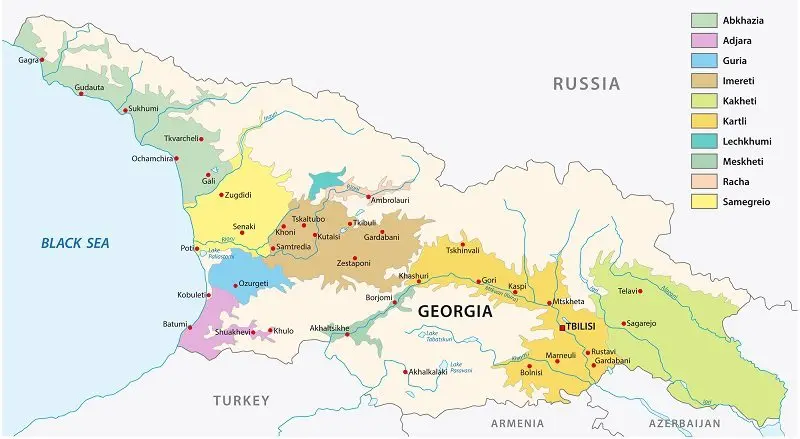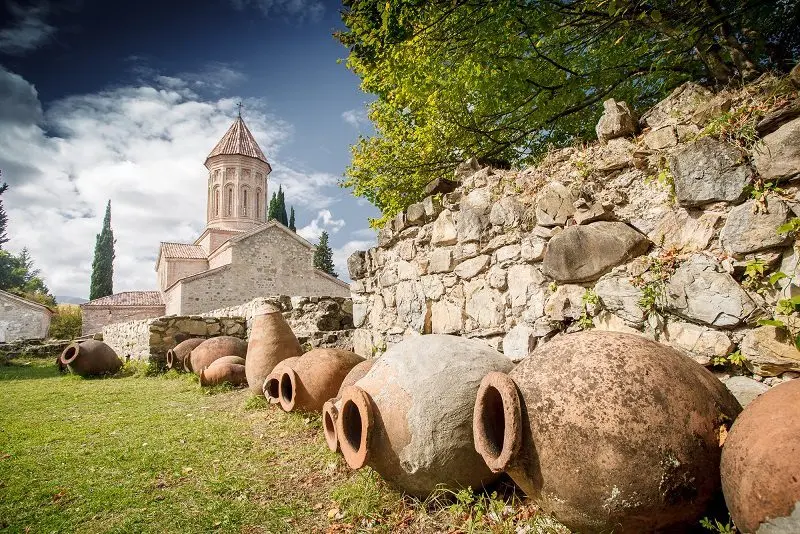Khvanchkara is a Georgian red naturally semi-sweet wine with a strength of 10,5-12 degrees and a sugar content of 3-5%, produced in the Racha-Lechkhumi region. Khvanchkara has a rich ruby color with a purple tint, the bouquet is dominated by tones of red berries, raspberries, strawberries, caramel, pomegranate, roasted almonds, blackberries, dried fruits, violets and roses.
Khvanchkara wine is made from two autochthonous grape varieties: Mujuretuli and Aleksandrouli. The first, although rare, is found in other regions, while the second is cultivated only in the town of Racha, since at the slightest change in terroir (climate, soil and other conditions) it instantly changes its taste.

The history of Khvanchkara is inextricably linked with the names of two Georgian princes, Lebanon and Dmitry Kipiani. Young aristocrats for many years made a drink according to traditional recipes for their own consumption, and in 1907 they presented their achievement at a wine exhibition in Belgium. The wine suddenly took first place, received a gold medal and the name “Kipianevskoe”.

In 1932, the name “Kipianevskoe” had to be changed, since it was inconvenient for the leader of the proletariat, Comrade Stalin, to drink wine glorifying class enemies. In order to avoid conflicts, the name of the wine-growing microzone, in which the region of production is located, was used – Khvanchkara.
In 2012, the Georgian government succeeded in securing the brand for a specific appellation at the international level. Now the Georgian wine Khvanchkara is a name controlled by origin. Only manufacturers of a small area, in full compliance with the classical production technology, have the right to put the Khvanchkara marking on the label.

Red wine Khvanchkara belongs to the category of naturally semi-sweet. This means that sugar is not added to the composition, since due to the peculiarities of the fermentation technology, enough natural glucose remains in the drink.
The berries are harvested when the sugar content reaches at least 22%. Then the grapes are crushed, but the pulp is not separated from the juice, but everything is placed together in special clay jars – Qvevri. There, the wort begins to ferment, but due to night frosts, the process is slow, sometimes even stops, so the sugar is not completely fermented by the yeast. Before bottling, the wine is pasteurized.

No more than 10 thousand bottles of Khvanchkara are produced per year, this is a rare and expensive wine. With the collapse of the Soviet Union, difficulties arose with excises, Georgia itself entered a period of economic crisis, the area of vineyards decreased – in those days there was almost no real Khvanchkara on the market, but many fakes appeared.
Today, Georgian wine is freely exported to the Russian market, but fakes are still not uncommon. To purchase exactly original products, carefully read the label – no more than 10% Saperavi is allowed in the composition of the drink (it is better if this variety does not exist at all), the country of origin is necessarily Georgia. Focus also on the price – real Khvanchakara cannot cost less than $40-50 per bottle.
How to drink Khvanchkara
Khvanchkara is served at 12-14°C in red wine glasses. The drink goes well with meat dishes, poultry, desserts, fruits, nuts, spicy or soft cheese. However, experts categorically do not recommend serving fish with this wine.

Famous manufacturers
Located in the appellation of the same name. In particular, these are the “House of Georgian Wine”, “Badagoni”, “Marani” (Telavi Wine Cellar) and others.









